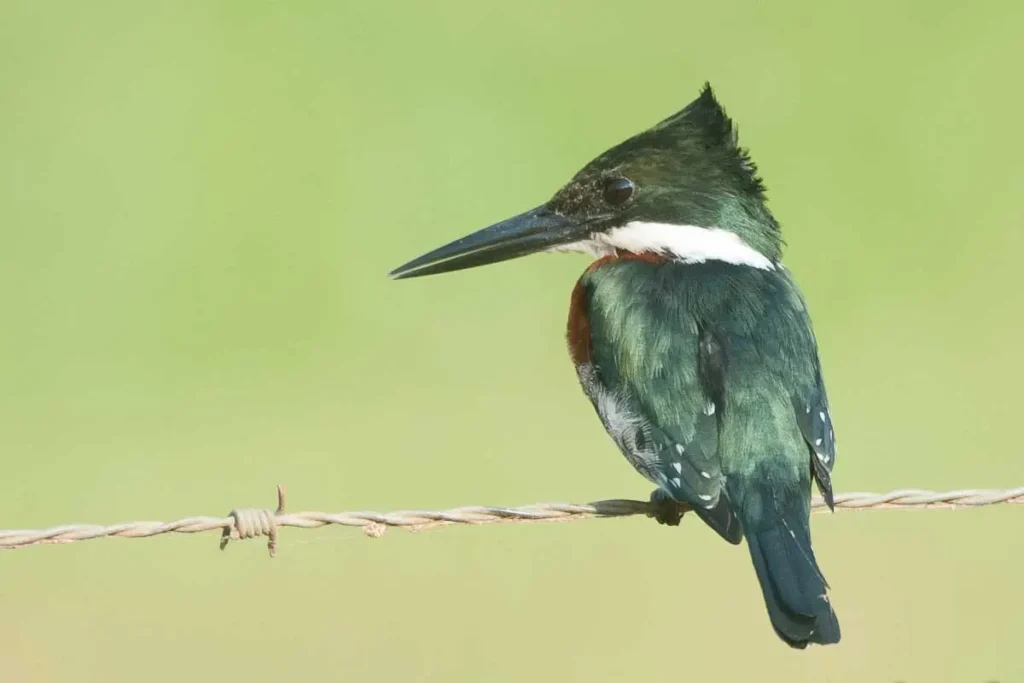
The green kingfisher (Chloroceryle americana), also known as the American green kingfisher, is a small, fascinating bird species that inhabits North and Central America. This article delves into the captivating world of green kingfishers, exploring their physical characteristics, habitat, feeding habits, nesting, and breeding behaviors.
Physical Characteristics
Green Upperparts and Buff White Underparts
The green kingfisher, like others such as the American Pygmy Kingfisher, is a small bird, measuring about 19-20 cm in length. It has striking green upperparts and buff white underparts. The green spots on the wing coverts and the oily green color on the back and wings create an eye-catching appearance. The bird’s tail is dark brown with white spots.
Sexual Dimorphism
Green kingfishers exhibit sexual dimorphism, with adult males and adult females showing distinct differences in appearance. Males have a rufous breast, while females display buff spots on their breast.
Long Bills and Quick Wingbeats
Green kingfishers have long bills, which they use to catch small fish and other prey. They have quick wingbeats, allowing them to move swiftly through the air.
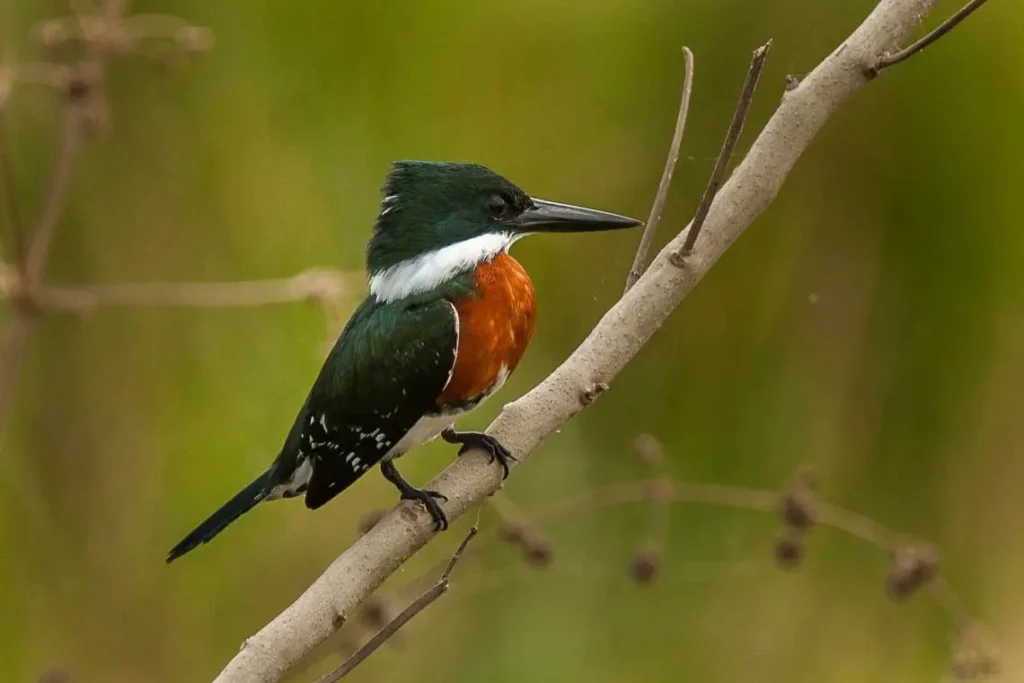
Distribution and Habitat
Green kingfishers have a wide range, extending from southern Texas and eastern Mexico south to northern Colombia, central Argentina, and central Brazil. They can also be found in coastal lagoons and forest streams of eastern Mexico south to South America east. The green kingfisher Chloroceryle americana is more commonly found in South and Central America than in North America.
Green kingfishers prefer habitats near rivers, streams, and ponds with overhanging vegetation. They can also be found near larger rivers and coastal lagoons.
These birds often perch low on overhanging vegetation or low perches near water. This allows them to easily spot small fish swimming and other prey in the water below.
Feeding Habits
Small Fish and Aquatic Insects
Green kingfishers primarily feed on small fish and aquatic insects. They also consume small lizards and other small creatures.
Perch Low to Detect Prey
To catch their prey, green kingfishers perch low near water and use their keen eyesight to detect small fish swimming or other prey. Once they spot a potential meal, they dive into the water with incredible speed and precision, snatching the prey with their long bills. They then return to their perch to consume their catch.
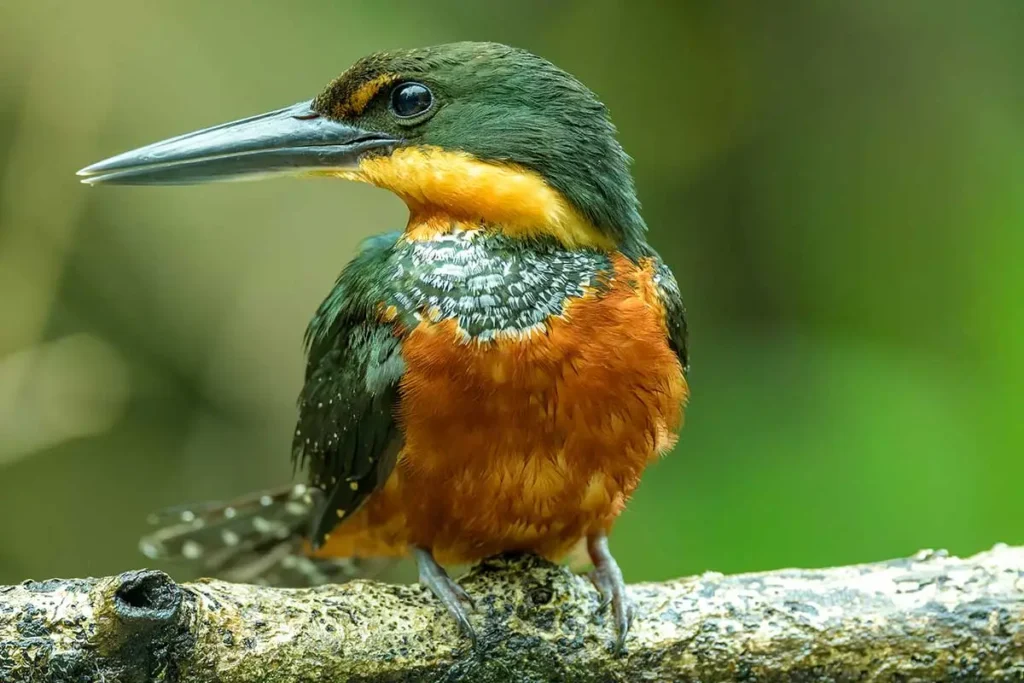
Nesting and Breeding
Nest Burrows in River Banks
Green kingfishers build their nest burrows in river banks, often near overhanging vegetation. They use their long bills to excavate the burrow, which can be up to 1 meter long. The nest is lined with fish bones and scales to create a comfortable environment for the eggs and young birds.
Nesting Season and Egg Incubation
The nesting season for these kingfishers typically occurs from February to August, depending on the location. During this time, the female lays between 3 and 6 eggs. Both the male and female take turns incubating the eggs, but the female incubates them more often than the male. The incubation period lasts approximately 22-24 days.
Days After Hatching
The young birds are born helpless and blind. They remain in the nest for about 27 days after hatching before they are ready to leave. During this time, both parents feed the chicks, providing them with a diet of small fish and water insects.
Green Kingfisher Subspecies and Other Kingfisher Species
Subspecies of Green Kingfisher
There are five recognized subspecies of the green kingfisher (Chloroceryle americana), which vary slightly in size, coloration, and geographical range. These subspecies include:
Chloroceryle americana americana: Found from eastern Mexico south to South America east, north of Colombia, and central Argentina.
Chloroceryle americana hachisukai: Occurs in southern Arizona, southern Texas, and the Mexican border.
Chloroceryle americana mathewsii: Inhabits northern Central America, including parts of Guatemala, Belize, Honduras, and Nicaragua.
Chloroceryle americana septentrionalis: Located in southern Central America, from Costa Rica to western Panama.
Chloroceryle americana cabanisii: Found in Brazil and parts of Bolivia, Paraguay, and Argentina.
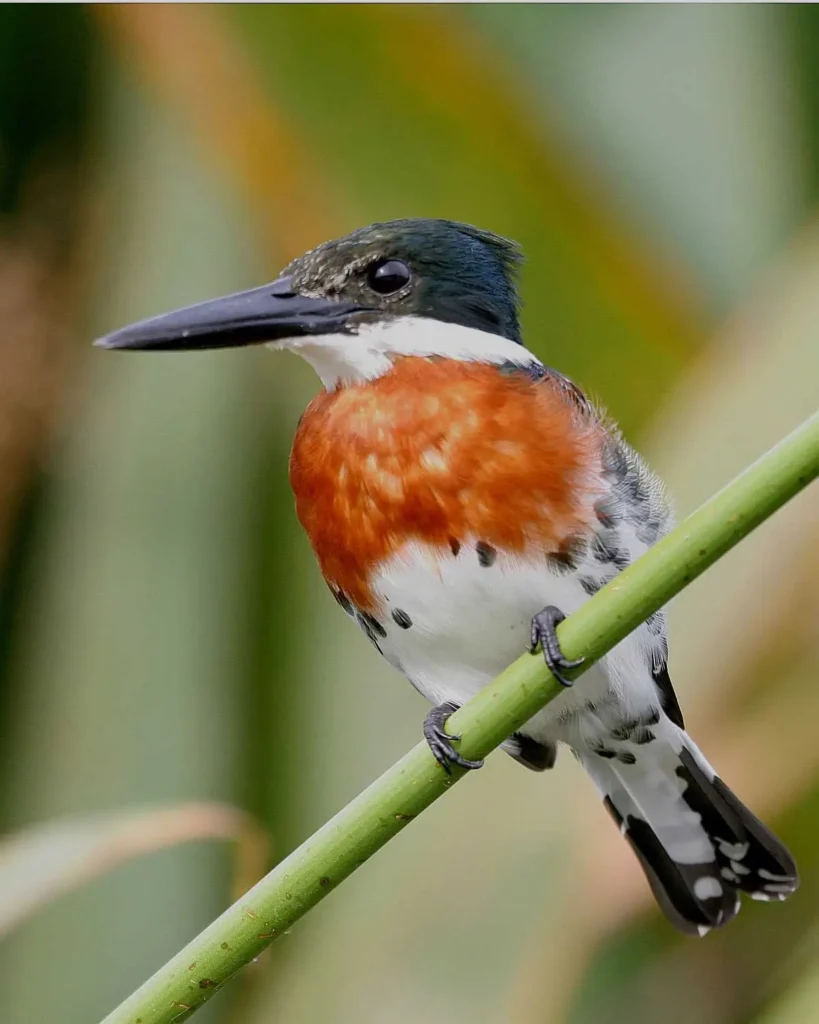
Comparing Green Kingfishers to Other Kingfishers
Green kingfishers are part of the family Alcedinidae, which includes approximately 90 species of kingfishers. While they share many similarities with other kingfishers, such as their vibrant colors, long bills, and reliance on aquatic habitats, green kingfishers are smaller and more specialized in their feeding habits. They are also more adept at maneuvering through dense vegetation, thanks to their wingbeats and agile flight.
In North America, these kingfishers are most closely related to the belted kingfisher (Megaceryle alcyon) and the ringed kingfisher (Megaceryle torquata). Compared to these other kingfisher species, the green kingfisher is smaller, with a more vivid green plumage and a distinctive white collar.
Migration and Wintering Behavior
Green kingfishers are primarily sedentary, meaning they do not engage in long-distance migrations. However, they may exhibit local movements in response to changes in habitat or food availability. In some parts of their range, such as southern Texas and Arizona, green kingfishers may move to lower elevations during the winter months to find suitable foraging areas.
Conservation Status
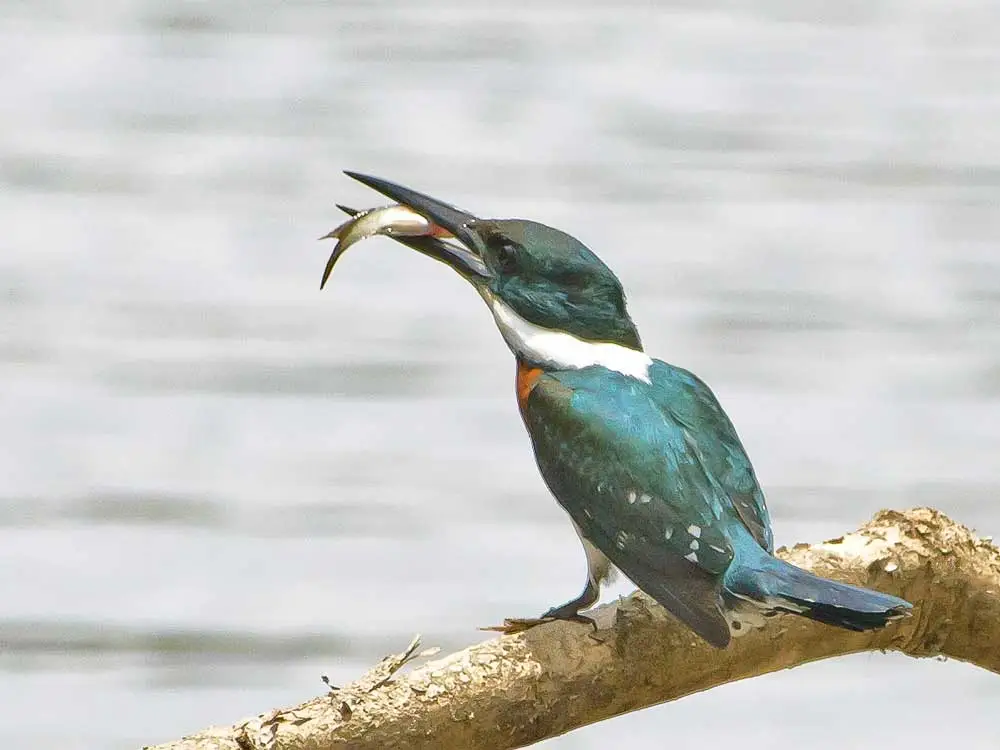
BirdLife International and International Ornithologists Union
According to BirdLife International, the International Ornithologists Union and the IUCN Red List, the green kingfisher is currently considered a species of “Least Concern.” This means that the bird’s population is stable, and it is not facing any immediate threats. However, it is essential to continue monitoring green kingfishers and their habitats to ensure their ongoing survival.
Cultural Significance and Scientific Study
The green kingfisher has long been a subject of fascination for both amateur birdwatchers and professional ornithologists. Its striking appearance, unique behaviors, and wide range have made it a popular subject for study and observation.
In scientific literature, the green kingfisher has been extensively documented and researched. Some notable publications include the “Handbook of the Birds of the World” by Josep del Hoyo, Andrew Elliott, and Jordi Sargatal, and “The Birds of North America” by Robert G. Pyle, published by the Oxford University Press.
In addition to its scientific importance, the green kingfisher has also appeared in various cultural contexts. For example, in French, it is known as the “Martin pêcheur vert,” and in Spanish, it is called the “Martín pescador verde.” The bird’s vibrant colors and distinctive appearance have made it a popular subject for artwork, photography, and literature, as well as a symbol of the rich biodiversity found in the Americas.
By understanding and appreciating the green kingfisher and its unique qualities, we can better appreciate the incredible diversity of bird species that inhabit our planet. Through continued research and conservation efforts, we can ensure that the green kingfisher and other species continue to thrive for future generations to enjoy.
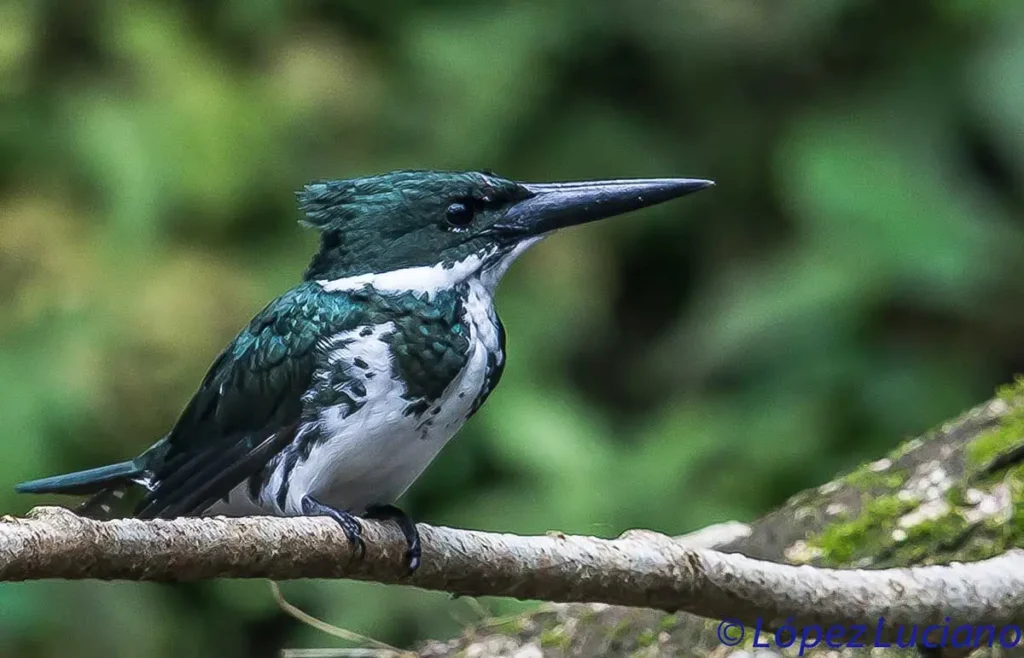
Conclusion
The green kingfisher is a remarkable bird with striking colors, unique feeding habits, and fascinating nesting behaviors. Its wide range across North, Central, and South America means that it can be found in various habitats, from rivers and streams to coastal lagoons. While green kingfishers are currently not at risk, it is crucial to remain vigilant and protect their habitats to ensure these captivating birds continue to thrive.
